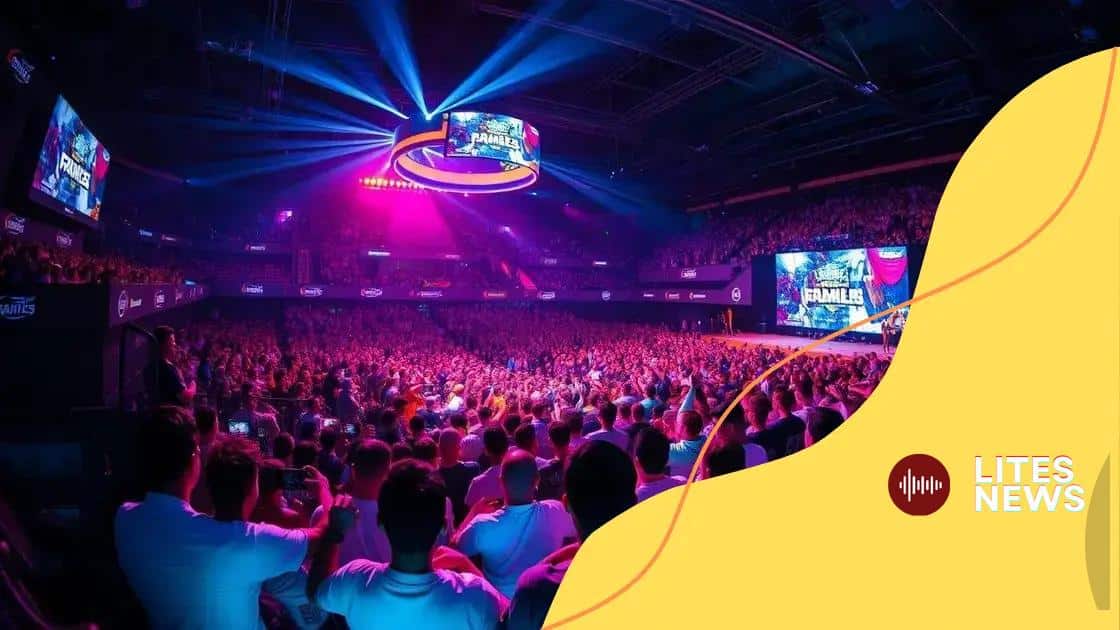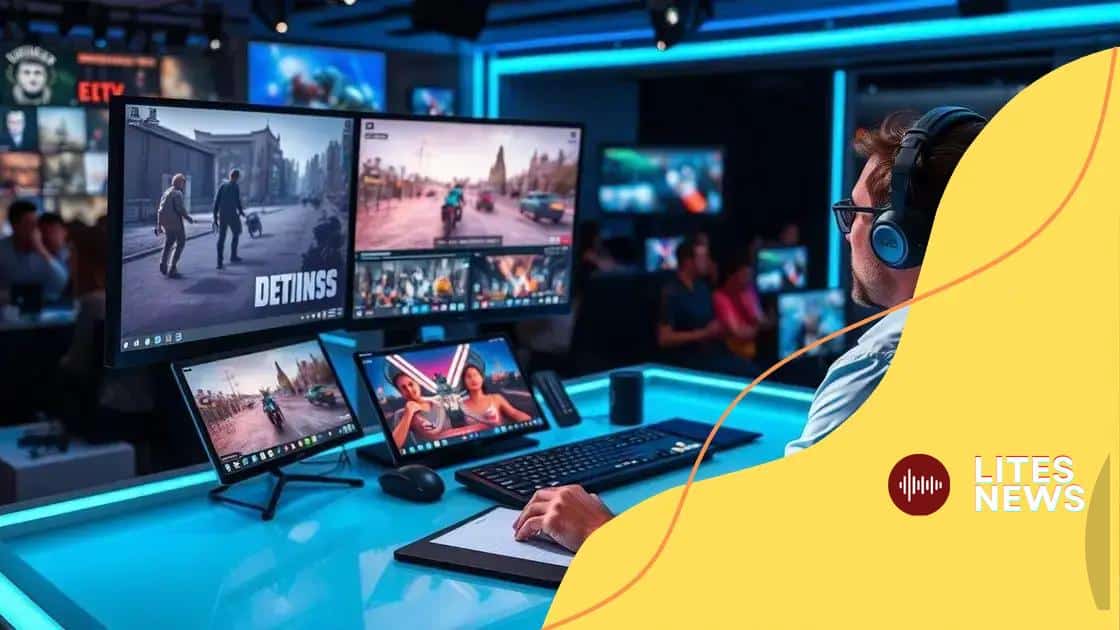How e-sports are influencing mainstream media content

How e-sports are influencing mainstream media content is evident in the increasing coverage of gaming events, the integration of e-sports into traditional sports programming, and the growing role of social media in engaging audiences.
How e-sports are influencing mainstream media content may seem like a niche topic, but it’s reshaping how we consume entertainment. Think about how gaming has shifted from a pastime to a massive industry—are you curious about its impact on news and television?
The rise of e-sports and its popularity
The rise of e-sports has transformed gaming into a mainstream entertainment powerhouse. Millions of fans gather to watch competitive gaming, turning virtual battles into thrilling events.
Key Factors Behind E-Sports Popularity
Several factors contribute to the soaring popularity of e-sports. The blend of skill, strategy, and entertainment captures audience attention worldwide.
- Accessibility: With online streaming platforms, anyone can watch their favorite teams or players compete from the comfort of home.
- Community Engagement: E-sports foster a strong sense of community among fans, creating spaces for interaction and shared experiences.
- Innovative Gameplay: The complexity and excitement of games draw in both traditional sports fans and gamers alike.
Additionally, prestigious tournaments and organized leagues enhance the competitive aspect. Events like the League of Legends World Championship bring in huge audiences, filling arenas with cheering fans. These gatherings elevate the status of players, treating them like athletes. Broadcasting these events on mainstream platforms has further propelled the growth of e-sports.
Traditionally, sports like basketball and football dominated the attention of media outlets. However, e-sports is redefining what it means to be an athlete and a fan. This evolution opens new advertising opportunities, as brands recognize the potential of reaching younger audiences through sponsorships and partnerships with e-sports teams.
Future Trends in E-Sports
Looking ahead, the evolution of technology promises to enhance the viewing experience for fans. Virtual reality and enhanced interactive features are on the horizon. As e-sports continue to grow, expect more collaboration with mainstream media, further blurring the lines between traditional and digital entertainment.
How e-sports events shape TV programming
How e-sports events shape TV programming is an interesting topic that showcases the influence of competitive gaming on mainstream media. As e-sports gain popularity, traditional television networks are adapting their programming to include this vibrant community.
Integration of E-Sports in TV
Major networks now dedicate airtime to e-sports tournaments, recognizing the massive viewership they attract. This shift illustrates how e-sports is becoming a staple in entertainment schedules.
- Dedicated Channels: Some networks have created channels specifically for e-sports, providing fans with constant access to their favorite games.
- Live Broadcasting: E-sports tournaments are streamed live, allowing viewers to experience the excitement in real time.
- Special Events: Networks host special events that marry traditional sports with e-sports, attracting audiences from both realms.
In addition to dedicated programming, networks analyze viewership data to tailor their content. Understanding what games and tournaments draw the largest audiences helps networks make informed decisions about future broadcasts. This data-driven approach ensures that content remains relevant and engaging for viewers.
This blending of gaming and traditional media is a game-changer. Viewers can now watch their favorite games while experiencing the thrill of live commentary and analysis that traditional sports offer. The cross-pollination between e-sports and mainstream television signals a broader acceptance and recognition of gaming as a legitimate form of entertainment. Television audiences are becoming more diverse, reflecting the growing e-sports community that includes people from various backgrounds and age groups.
The Future of TV Programming with E-Sports
As technology advances and more people embrace gaming, we can expect e-sports to continue influencing TV programming. The growth of virtual reality and interactive features may further enhance the viewing experience, making it highly immersive. This evolution will likely pave the way for new formats and programming styles that enhance our connection to both e-sports and traditional media.
Influence of gaming culture on traditional journalism

The influence of gaming culture on traditional journalism is profound and multifaceted. As e-sports and gaming become mainstream, they are reshaping how news is reported and consumed, creating new opportunities for journalists and media outlets.
Emergence of Gaming Journalism
Gaming journalism has emerged as a distinct field, focusing on reporting the latest in gaming, reviews, and industry trends. This niche has gained immense popularity, reflecting the growing interest in video games. In many cases, traditional media outlets have integrated gaming news into their main content, recognizing the significance of this audience.
- Game Reviews: Detailed reviews help gamers make informed decisions before purchasing titles.
- Industry News: Reporting on developer announcements, game releases, and e-sports events keeps readers updated.
- Interviews: Conversations with game developers and influencers provide unique insights into the gaming world.
Moreover, gaming culture has introduced a new way for journalists to connect with audiences. By engaging in live streams, social media, and forums, journalists can interact directly with readers, paving a way for a deeper understanding of audience interests and needs. This direct engagement fosters a sense of community, making the journalistic experience more relatable and interactive.
The shift to online platforms has also changed how news is delivered. Traditional formats, like print journalism, struggle to keep pace with the fast-moving nature of the gaming industry. Online articles, videos, and live broadcasts are becoming the norm, allowing for real-time updates on breaking news and events.
Challenges in Gaming Journalism
Despite its growth, gaming journalism faces challenges. The rapid evolution of technology and platforms requires journalists to stay ahead of trends. This fast-paced environment can lead to misinformation or rushed reporting. It’s essential for journalists to maintain credibility and thoroughness, even in the quest for speed.
As gaming culture continues to influence traditional journalism, we see a blending of styles. The integration of visual storytelling and interactive content is becoming more common, capturing the essence of gaming and appealing to a wider audience. This evolution indicates a promising future for journalism and its role in the gaming industry.
The role of social media in e-sports coverage
The role of social media in e-sports coverage has become vital. These platforms allow fans, players, and teams to connect in real time, creating a dynamic and engaging environment for the community.
Instant Updates and Engagement
Through social media, updates about tournaments, scores, and player performances spread quickly. Fans can follow their favorite teams and players, receiving instant notifications about important events. This immediacy enhances engagement as followers can comment and share content, promoting a sense of community.
- Live Streaming: Platforms like Twitch and YouTube allow gamers to broadcast their gameplay, inviting audiences to join in and interact.
- Behind-the-Scenes Content: Teams use social media to share insights into their daily routines, training, and preparations, making their journey transparent.
- Fan Interaction: Fans can participate in discussions, polls, and contests, increasing their investment in outcomes.
Additionally, e-sports organizations leverage social media for marketing. Sponsorship deals are often promoted through these channels, boosting visibility for both the teams and their partners. Collaborations with influencers help in reaching broader audiences and attracting new fans to the sport.
Social media not only serves as a platform for communication but also acts as a news source. Many journalists and content creators share updates and analyses, making it easier for fans to stay informed about the latest happenings in the e-sports scene. This blend of content enhances the overall experience for viewers.
Building a Stronger Community
The interaction fostered by social media also contributes to community building within the e-sports realm. Fans share memes, create content, and advocate for their favorite teams. This grassroots promotion creates an inclusive environment where newcomers feel welcomed. As players interact with their fans, it humanizes them and creates a personal connection.
Moreover, platforms like Twitter, Instagram, and Discord facilitate discussions among players and fans, allowing for feedback and shared experiences. This connectivity forms bonds that transcend geographical boundaries, solidifying a global community centered around shared interests in gaming.
Future trends: e-sports in mainstream media
The future trends of e-sports in mainstream media are fascinating and filled with potential. As gaming continues to grow and attract audiences, we can expect it to become even more integrated into traditional media formats.
Increased Coverage and Accessibility
One major trend is the increase in coverage of e-sports events across various media platforms. Major networks are recognizing the profitability of broadcasting tournaments, leading to more accessible viewing experiences. With highlights, analysis, and live events, audiences can engage with the content in various ways.
- Diverse Platforms: E-sports will be found on multiple platforms, from cable TV to streaming services and social media.
- Engaging Content: Expect innovative approaches to storytelling, such as behind-the-scenes footage and player interviews, making the audience feel closer to the action.
- Interactive Experiences: Technologies like virtual reality could allow viewers to immerse themselves in the gameplay, enhancing the overall spectator experience.
Moreover, as more advertisers and brands invest in e-sports, the quality and quantity of the programming will likely improve. This investment means bigger sponsorships, better production quality, and more substantial marketing campaigns, creating a richer environment for fans.
Blurring Boundaries with Traditional Sports
Another trend is the blending of e-sports with traditional sports. Many traditional sports leagues are partnering with e-sports organizations, collaborating on events and audience engagement strategies. These crossover events draw in fans from both areas, creating a unique entertainment experience.
As part of this synergy, we may see e-sports integrated into regular sports broadcasts, featuring segments during halftime or special events that showcase gaming skills, making it relatable and familiar to traditional sports fans.
The growth of e-sports also means that universities and colleges are investing in gaming programs and scholarships. This focus on education is shaping a new generation of players and fans, further embedding e-sports into the cultural landscape.
The Role of Technology
Technology will continue to play a significant role in the evolution of e-sports in mainstream media. Improvements in streaming technology, including higher quality video and faster access to content, will enhance viewer experience. Blockchain and cryptocurrencies may also impact how the industry operates, opening up new avenues for fan engagement and participation.
As the lines between digital and traditional media continue to blur, we can expect e-sports to grow in prominence, evolving into a staple of entertainment that captivates audiences worldwide.
FAQ – Frequently Asked Questions about E-sports and Media
How are e-sports influencing traditional media?
E-sports are becoming a significant part of mainstream media, with more networks covering events and integrating them into their programming.
What platforms are best for watching e-sports?
You can watch e-sports on various platforms, including Twitch, YouTube, and dedicated sports channels that broadcast gaming tournaments.
How is social media impacting e-sports coverage?
Social media allows for real-time updates, fan interaction, and sharing of content, enhancing the overall engagement and community around e-sports.
What future trends can we expect in e-sports?
Expect increased integration with traditional sports, advancements in technology for better viewing experiences, and more diverse content across platforms.





